W2MPIR: A2AD Neutralization Tool by the WB Group
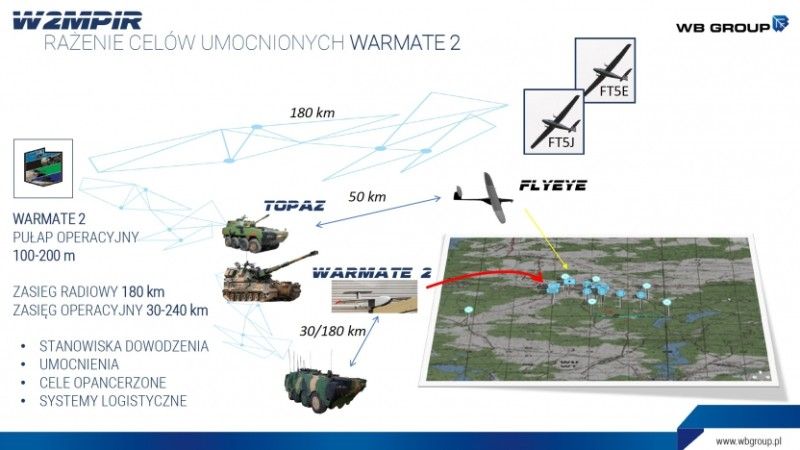
The WB Group suggests that a fusion of BMS solutions and broad use of unmanned reconnaissance/strike assets could become a system that would make it possible to gain operational advantage on the contemporary battlefield. Effective neutralization of the enemy’s A2/AD tactics is to be ensured by the W2MPIR system (Wielowarstwowy Wielozadaniowy Modułowy Powietrzny Inteligentny Rój - Multi-layered, Multi-purpose, Modular, Aerial Smart Swarm).
As stressed by Adam Bartosiewicz, Vice-President at the WB Group, establishing superiority in the ICT domain bears the key relevance on the future or current battlefield - the ICT domain may have replaced the air domain here. The potential adversary is engaged in the development of electronic warfare and SIGINT assets, to paralyze the datalink systems, navigation, and C2 assets, preventing the adversary from conducting the operations in a manner that would be effective. These assumptions have been adopted for the original A2/AD concept. Originally, it referred to the air domain. Nowadays, they serve as a multi-spectral tool for isolating the enemy forces.
The WB Group’s offering is a solution that is to make it possible to identify and effectively eliminate the key enemy assets, to make it possible to efficiently conduct own operations. It is also a tool that can be used to suppress the enemy defence by eliminating the key targets, for example by conducting SEAD operations to make it possible for the airstrikes to commence.
The system is made of operationally proven solutions (used by the military), also in circumstances when actual Russian-made EW assets were being used. W2MPIR revolves around the expanded variant of the Topaz BMS, using a secure communications system referred to, by the WB Group, as the Silent Network. Alongside the basic functionalities - communications and data transfers - the system also ensures effective positioning, navigation, and target designation - also when GPS spoofing systems are being employed by the enemy.
Securely, Silently, Effectively
Establishing communications when the enemy's EW assets are active is key. Adam Bartosiewicz claims that the Silent Network provides the user with the capability to do so, exhibiting good specification when it comes to security and functionalities. This has been made possible thanks to the PERAD personal radio, developed for the Polish Tytan system - the future combat ensemble for individual soldiers. The radio combines broadband communications capability at a range of up to 10 kilometers, allowing for transmission of imagery gathered by the Body Worn Cameras or loitering munitions, as well as lower bandwidth communications - at a range of 50 kilometers.
The radio is scalable which means that it can be integrated on a vehicular/UAV platform, or used as a personal radio system. It exhibits far greater endurance than the competing designs, also capable of utilizing 700 times per second frequency hopping capability, with simultaneous scanning of the frequency range and omission of the jammed frequencies. The whole network utilizes individual pieces of hardware to retransmit the signal, but it also forms a reference system, being an alternate solution to GPS or Galileo systems, making it possible to precisely define the position of objects in relation to the radio. This makes it possible to navigate or designate targets, also in circumstances where the enemy employs strong countermeasures.
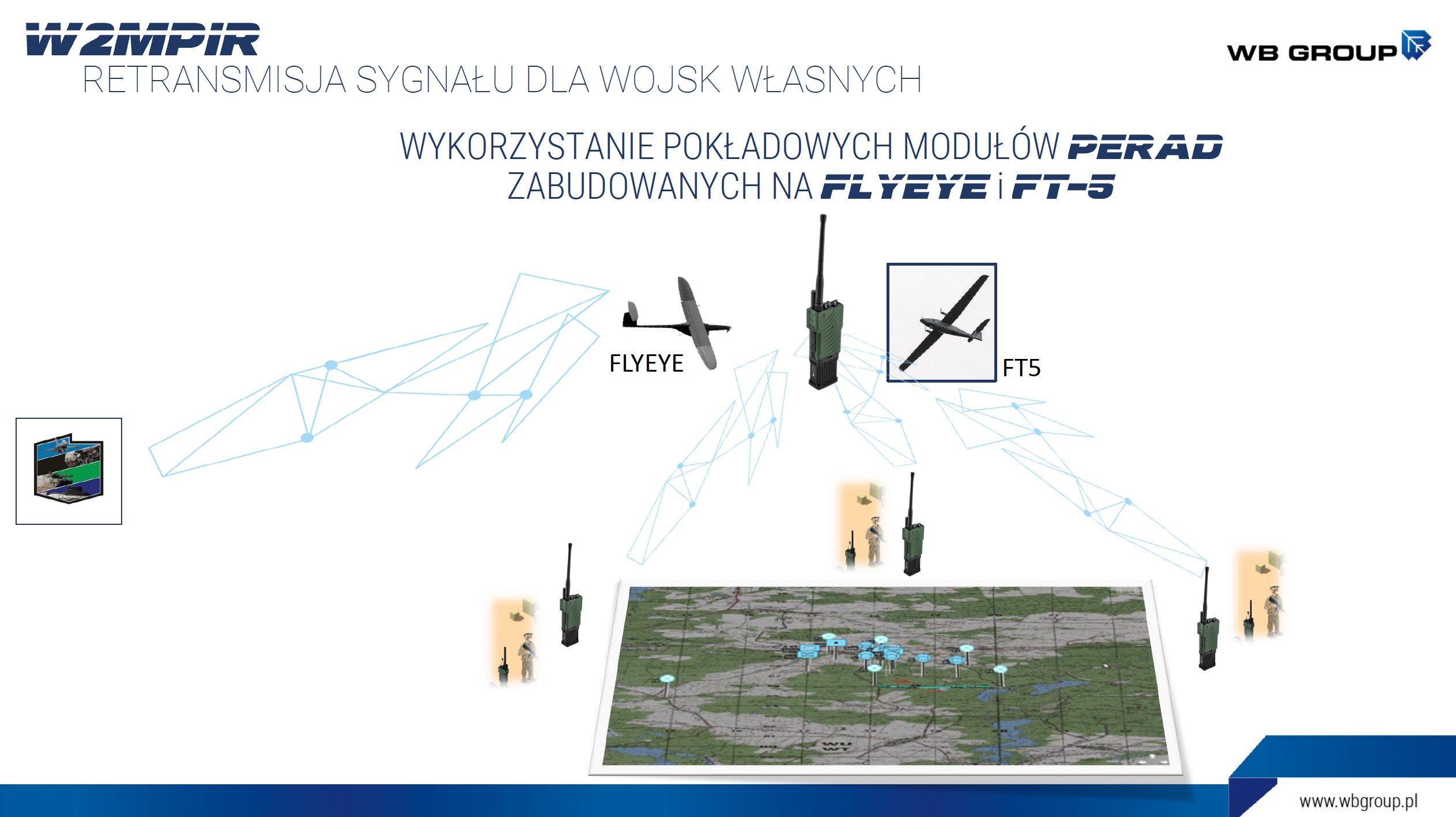
The whole solution is managed by the expanded variant of the Topaz system. Topaz makes it possible to manage information downloaded from a myriad of reconnaissance systems, for optimal employment of available assets. W2MPIR has been developed as a proposal for integration of the Warmate loitering munitions and FT-5/FlyEye UAVs into one system, with the latter also acting as the Silent Network retransmission assets or means of electronic warfare. The system may also be used for forward controlling of artillery or aviation. Silent Network acts as a battle management system at the battalion level, and it may be deployed at higher levels as well. The whole system is modular and scalable, thus the user may procure configuration meeting his needs. Apart from the Silent Network radios, and the Topaz integrated BMS, W2MPIR also includes several key components.
FlyEye and FT-5 - Unmanned Multi-Role Assets
FlyEye mini-UAV is the most recognizable of the WB Group’s UAVs. The system in question has been operated for years by the Polish Armed Forces. Nonetheless, the development of FlyEye has also been influenced, to a significant degree, by the fact that the Ukrainian Armed Forces employ this system during the conflict, near the eastern border. It is a relevant factor that influenced the development of the W2MPIR system, as the separatists utilize Russian EW systems, used both for jamming, as well as for detection and identification. Despite the above, not a single FlyEye has been lost in Ukraine so far, even though the proliferation of EW assets often led to a loss of communications or even temporary incapacitation of some of the onboard systems.
FlyEye is known best for its reconnaissance capabilities. However, thanks to the fact that the mission module of the UAV can be replaced, the system has new capabilities, such as retransmission of the RF communications. This makes it possible to expand the range of control for a variety of UAVs, but also to establish networked communications, within the Silent Network. The relatively light, hand-launched aircraft weighs 12 kilograms and has a wingspan of 3.6 meters. FlyEye can be controlled at a distance of up to 50 kilometers. Nonetheless, the route-planning function makes it possible to use the said UAV at a greater distance.
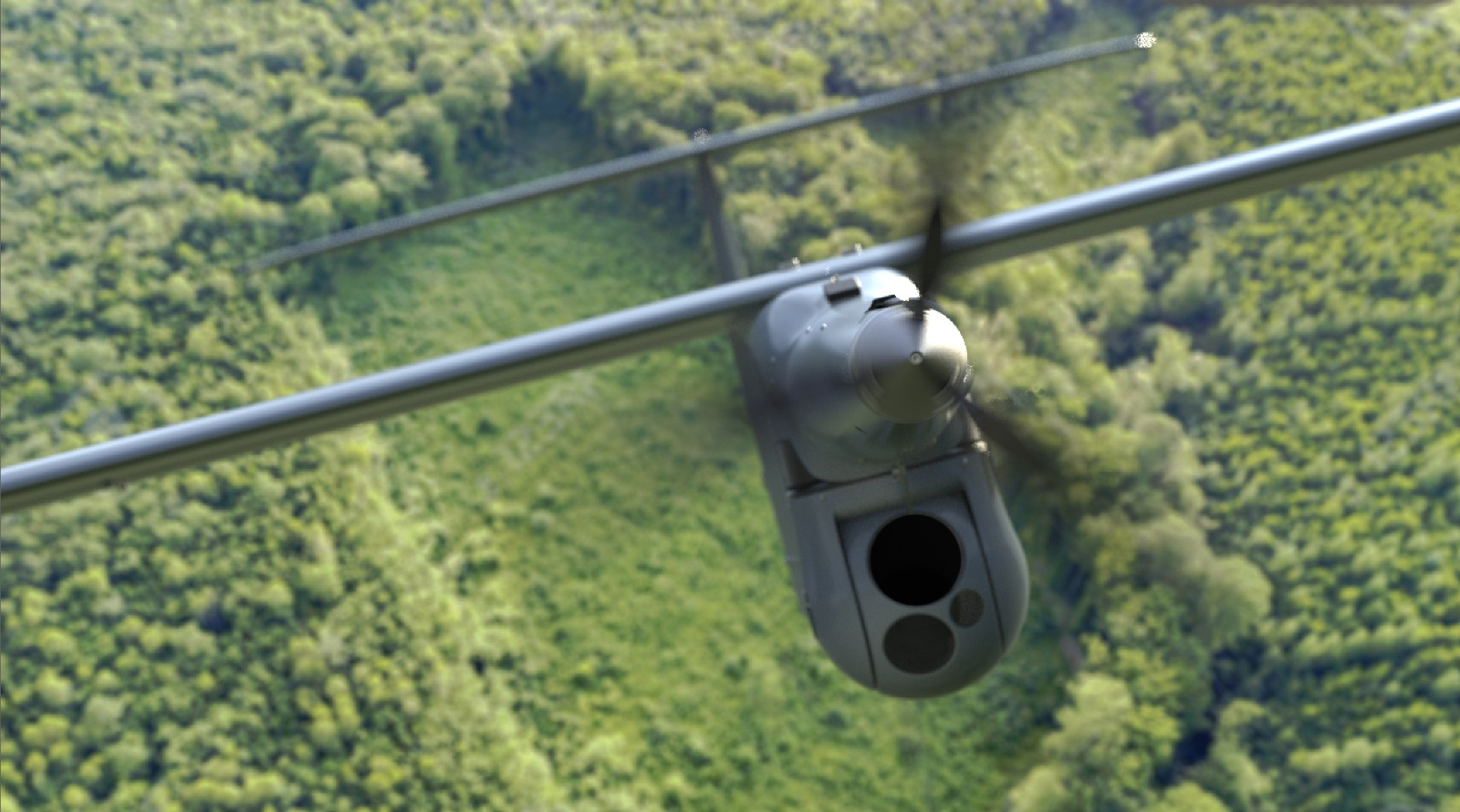
FT-5 twin-engined platform has much greater capabilities - with seven times higher MTOW, and doubled wingspan. Flytronic offers these aircraft three propulsion types - electric, internal combustion, and hybrid.
Contrary to the all-electric FlyEye, the propulsion for the new FT-5 (with fixed landing gear) is provided by two piston-driven engines. This provides the platform with greater endurance and payload capacity. Due to the high MTOW, the aircraft requires a vehicle-mounted launcher, or runway (in a variant with landing gear it uses several hundred meters of the runway). The system may be controlled at a distance of up 150 kilometers via a mobile control station, with a flight endurance of 10 hours.
The FT-5 features a daytime-night optronic system with a laser rangefinder and target designator. It may, however, carry other systems, including SIGINT/ELINT/SAR sensors, re-transmitters, or even ordnance. FT-5 may also carry Warmate TL loitering munitions. Flying at 5 thousand meters altitude, the FT-5 would be able to detect and identify targets at a distance of up to 150 kilometers. The FT-5 can see deep behind the enemy lines.
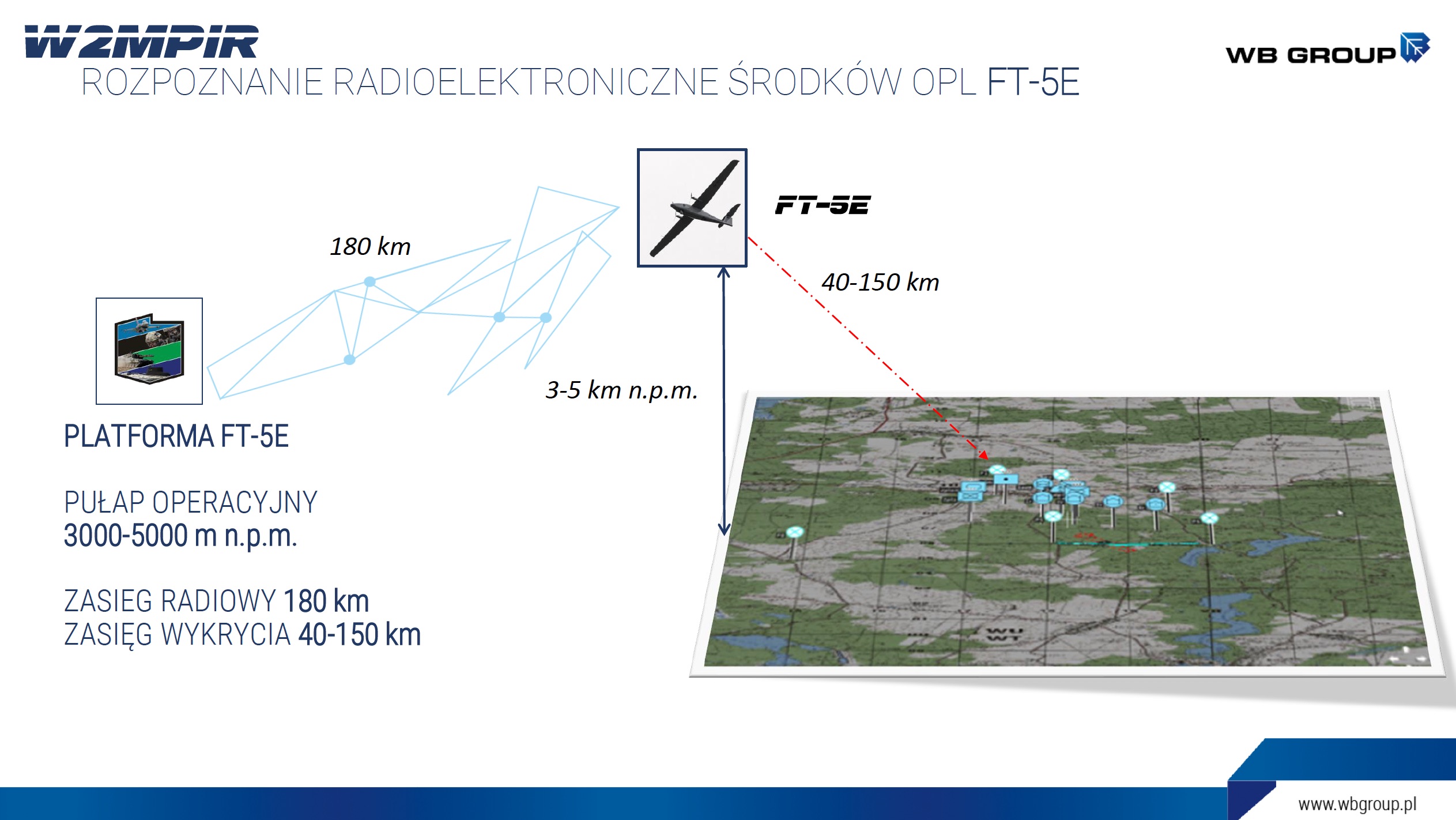
This paves a way towards striking a great variety of targets, including the key elements of the enemy A2/AD systems (such as air defence assets, radars, command posts, or EW assets). What is relevant, the aforesaid targets provide high levels of electronic contrast, which means that kinetic means can be guided directly against the enemy RF emitters. When it comes to the guidance and kinetic systems, the WB Group offers the Warmate loitering munitions. At the same time, a proposal has been made to change the concept for use of those, by expanding the Topaz Swarm system ideas.
Airborne Magazine - Swarm of Loitering Munitions 2.0
Using the commonality between FlyEye, FT-5 and Warmate platforms, the concept of a swarm has been extended, to an airborne magazine - loitering munitions, awaiting the assignment of missions and targets, while being airborne. On one hand, programmable route and patrol area functions are used here, on the other, programmable waiting time is utilized. Also, the option of transferring the control between control systems is crucial for that purpose. The U-Gate systems are the critical piece of kit. Being used jointly with the Silent Network radios, they allow for reception of intel from FlyEye and FT-5, and also for control of the UAVs and Warmate loitering munitions. The functionality had been used in the past - U-Gate used to control the aircraft outside its range. W2MPIR capitalizes on the said functionality, extending it.
The assumption is to create an airborne magazine/stack, where a large number of Warmate UAVs carrying a myriad of warheads are waiting for the assignment of tasks or targets. The operator may select one, or more aircraft, coordinating attacks against targets that are detected, and designated. As the tests have shown, a single U-Gate operator may be able to control several Warmate platforms at once. Thanks to the use of the "airborne magazine", the time between detecting and striking the target becomes shorter. It is also possible to carry out mass, coordinated oversaturation attacks - diminishing the capabilities of the enemy A2/AD system.
Three Generations of the Warmate System
As stressed by Adam Bartosiewicz, VP at the WB Group, even when the enemy utilizes decoys, employing a high quantity of cheap loitering munitions makes it possible to still make the strike effective. The Warmate UAVs stacked deep behind the frontline can reach the distant operational theater along the preplanned route, gather in one spot, and then be used based on the current intel provided by FlyEyes and FT-5s. The WB Group currently offers three different types of Warmate munitions.
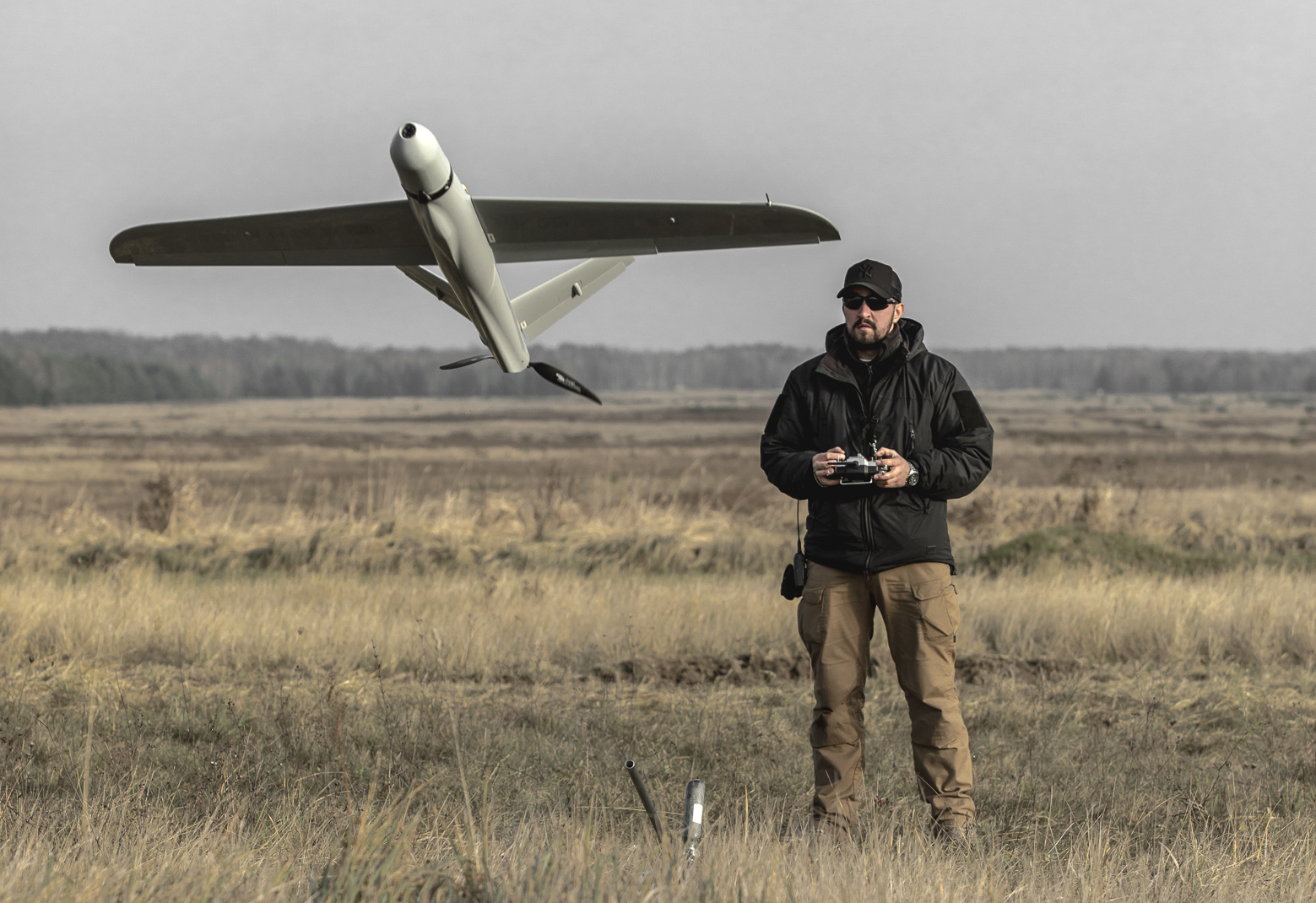
The first one is the basic Warmate variant - currently designated Warmate 3.0. It is a portable system that can be carried by two soldiers and prepped for take-off in a few minutes. Vehicular configuration is also available - such as the Ukrainian Sokil system integrated on Kozak-5 vehicle, housing the control station, loitering munitions and warheads, and a launcher. Warmate has been equipped with replaceable 1.4kg warheads (types range from HEAT, HE, to thermobaric, and others). The airframe is powered by an electric motor, with a flight endurance of 70 minutes. The aircraft may fly at a distance of 30 kilometers from a standard control station, or 80 kilometers away, if control is taken over by another operator, using the U-Gate solution for instance.
Read more: WB Group Tasked With Repairs and Modifications of the Topaz System for the Gvozdika Howitzers
Responding to some requirements, WB Group also developed the larger Warmate 2 system, weighing 30 kilograms and carrying 5-kilogram warheads. The UAV uses a special-purpose launcher for take-off, which is vehicle-mounted. It is identical to the one used for the FT-5 platform. The radio control range for the mobile, vehicular station is 180 kilometers. The aircraft can fly at distances of up to 240 kilometers. Due to the heavier warhead, Warmate 2 is capable of neutralizing heavy or fortified, or even armored targets and infrastructure, including command posts or storage facilities.
Warmate TL is the third, yet also the lightest variant of the system, weighing 4.9 kg and offering a range of 30 kilometers. It uses a containerized launcher system. The warheads are identical to the ones used by the standard Warmate drone (1.4 kilograms). The system may be installed on vehicles, or it may also be carried by air platforms, rotary-wing, and unmanned assets included. The flight endurance is shorter - 40 minutes. Nonetheless, a large quantity of aircraft can be sent into the air in a short period - this allows for oversaturation engagements. FT-5 can carry the Warmate TL munitions, becoming yet another type of airborne magazine, in line with the W2MPIR concept.
The fusion of these three types of Warmate makes it possible to flexibly utilize the kinetic capacity offered by this solution. These may be complemented with guided artillery, using the Topaz fire control system, or firing solutions provided via the aerial platforms. This makes it possible to effectively act against the enemy A2AD assets thus being able to conduct own operations. What is relevant is the fact that the whole system consists of individual, yet operationally proven components that, thanks to the W2MPIR system fusion of capabilities benefit from synergy - so important on the current, and prospective battlefield.
Article prepared in collaboration with the WB Group.
